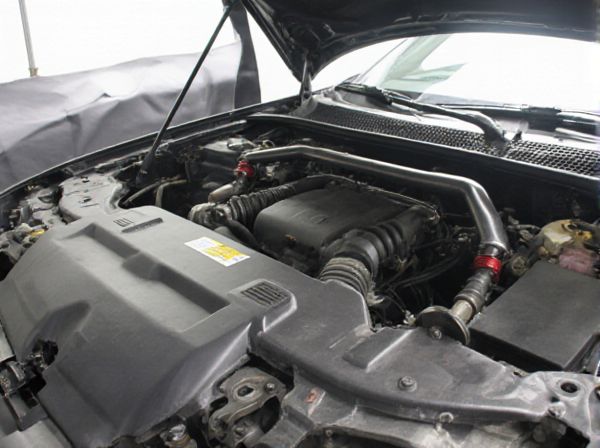
Photo illustration: Hood Struts vs Hood Prop Rod
Hood struts offer a modern, effortless way to lift and hold your car's hood securely, providing convenience and improved safety compared to traditional hood prop rods. Hood prop rods require manual positioning and can obstruct access to the engine bay, while hood struts automatically support the hood for hands-free operation. Choosing hood struts enhances your vehicle maintenance experience by ensuring quicker, more stable hood support.
Table of Comparison
| Feature | Hood Struts | Hood Prop Rod |
|---|---|---|
| Function | Supports hood automatically | Manual support with rod |
| Ease of Use | Simple, hands-free operation | Requires manual placement |
| Durability | Hydraulic gas-filled, moderate lifespan | Metal rod, long-lasting |
| Cost | Higher initial cost | Low cost, budget-friendly |
| Maintenance | May require gas refill or replacement | Minimal maintenance |
| Space Efficiency | No need for extra storage space | Stored separately when not in use |
| Safety | Stable and secure support | Risk of improper placement |
Introduction to Hood Struts and Hood Prop Rods
Hood struts and hood prop rods are essential components for safely holding a vehicle's hood open during maintenance or inspection. Hood struts use hydraulic pressure to provide controlled lifting and support, offering hands-free convenience and smooth operation. Hood prop rods, typically metal rods that manually secure the hood in place, are a simpler and more cost-effective solution commonly found in various car models.
How Hood Struts Work
Hood struts operate using gas-filled cylinders that provide consistent pressure to lift and hold the hood open without manual support, ensuring smooth and effortless operation. They utilize compressed nitrogen gas and oil to create damping and controlled motion, preventing sudden slams or drops. This mechanism contrasts with hood prop rods, which require manual positioning and do not offer controlled or assisted lifting.
How Hood Prop Rods Function
Hood prop rods function as a simple mechanical support system that holds the vehicle's hood open by fitting into a designated slot or hole on the hood's underside. These rods are typically made of metal and rely on manual placement and removal, offering a reliable, cost-effective alternative to hood struts. Unlike hood struts, which use gas pressure to lift and hold the hood automatically, prop rods require the user to physically position them, providing straightforward stability during engine maintenance.
Pros and Cons of Hood Struts
Hood struts offer effortless hood lifting and secure support without manual intervention, enhancing convenience and safety during engine access. They provide a sleek, modern look and reduce hood vibration, but typically come with higher initial costs and may require more complex installation compared to traditional hood prop rods. However, hood struts can wear out over time, potentially leading to costly replacements or reduced performance.
Advantages and Disadvantages of Hood Prop Rods
Hood prop rods offer a cost-effective and lightweight solution for supporting the car hood, providing easy manual operation without the need for complex mechanisms. However, they require physical effort to position and can obstruct access to the engine bay, posing a safety risk if not securely placed. Hood prop rods lack the convenience and automatic functionality of hood struts, which provide silent, hands-free support but come at a higher price and may degrade over time.
Installation Process: Struts vs Prop Rods
Hood struts install by securely mounting gas-filled pistons to pre-drilled points on the hood and vehicle frame, often requiring basic tools like wrenches and screwdrivers for a straightforward, bolt-on setup. Prop rods involve a simpler installation, typically requiring bolting a metal rod bracket to the hood and frame with minimal hardware, but may need precise alignment to ensure proper hood support. Struts provide automatic lift and hold functionality, eliminating manual adjustment required by prop rods during each use.
Maintenance and Longevity Comparison
Hood struts offer enhanced durability and require less maintenance compared to hood prop rods, as they are designed with sealed gas-filled cylinders that resist corrosion and wear. Prop rods, typically made of metal, may need regular inspection and occasional replacement due to rust or bending over time, impacting their longevity. The hydraulic mechanism of hood struts provides smoother operation and extended service life, making them a preferred choice for long-term hood support.
Cost Comparison: Struts vs Prop Rods
Hood struts typically cost between $50 and $150 per pair, while hood prop rods are much more affordable, generally ranging from $10 to $30. Installation expenses for hood struts may add $50 to $100 due to complexity, whereas prop rods often require minimal to no professional installation, keeping total costs low. Despite the higher initial investment, hood struts offer convenience and durability, potentially reducing long-term maintenance expenses compared to traditional prop rods.
Vehicle Compatibility and Customization
Hood struts offer enhanced compatibility with a wide range of modern vehicles, especially those designed for quick and easy hood access, while hood prop rods are more common in older or classic car models due to their simplicity and universal fit. Customization options for hood struts include adjustable gas pressure and sleek finishes, allowing for tailored performance and aesthetic appeal, whereas hood prop rods generally offer limited customization but excel in straightforward, reliable support. Selecting between hood struts and prop rods depends largely on the vehicle's design specifications and the owner's preference for functionality versus traditional styling.
Which Hood Support Option Is Right for You?
Hood struts provide a smooth, effortless lift and secure hold, ideal for drivers seeking convenience and modern functionality in vehicle maintenance. Hood prop rods offer a cost-effective, simple solution favored for their reliability and ease of manual adjustment during quick inspections. Selecting the right hood support depends on budget, frequency of hood access, and personal preference for automated versus manual operation.
 caratoz.com
caratoz.com